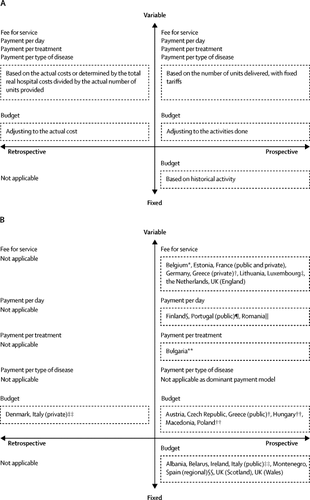当前位置:
X-MOL 学术
›
Lancet Oncol.
›
论文详情
Our official English website, www.x-mol.net, welcomes your
feedback! (Note: you will need to create a separate account there.)
How public health services pay for radiotherapy in Europe: an ESTRO-HERO analysis of reimbursement.
The Lancet Oncology ( IF 41.6 ) Pub Date : 2020-01-01 , DOI: 10.1016/s1470-2045(19)30794-6 Yolande Lievens 1 , Noémie Defourny 2 , Julieta Corral 3 , Chiara Gasparotto 4 , Cai Grau 5 , Josep Maria Borras 6 ,
The Lancet Oncology ( IF 41.6 ) Pub Date : 2020-01-01 , DOI: 10.1016/s1470-2045(19)30794-6 Yolande Lievens 1 , Noémie Defourny 2 , Julieta Corral 3 , Chiara Gasparotto 4 , Cai Grau 5 , Josep Maria Borras 6 ,
Affiliation

|
Reimbursement is a key factor in defining which resources are made available to ensure quality, efficiency, availability, and access to specific health-care interventions. This Policy Review assesses publicly funded radiotherapy reimbursement systems in Europe. We did a survey of the national societies of radiation oncology in Europe, focusing on the general features and global structure of the reimbursement system, the coverage scope, and level for typical indications. The annual expenditure covering radiotherapy in each country was also collected. Most countries have a predominantly budgetary-based system. Variability was the major finding, both in the components of the treatment considered for reimbursement, and in the fees paid for specific treatment techniques, fractionations, and indications. Annual expenses for radiotherapy, including capital investment, available in 12 countries, represented between 4·3% and 12·3% (average 7·8%) of the cancer care budget. Although an essential pillar in multidisciplinary oncology, radiotherapy is an inexpensive modality with a modest contribution to total cancer care costs. Scientific societies and policy makers across Europe need to discuss new strategies for reimbursement, combining flexibility with incentives to improve productivity and quality, allowing radiation oncology services to follow evolving evidence.
中文翻译:

欧洲的公共卫生服务如何为放射治疗付费:ESTRO-HERO的报销分析。
报销是定义可提供哪些资源以确保质量,效率,可用性以及获得特定医疗干预措施的关键因素。本政策评估评估了欧洲公共资助的放射治疗报销系统。我们对欧洲放射肿瘤学国家协会进行了一项调查,重点研究了报销系统的一般特征和全球结构,覆盖范围以及典型适应症的水平。还收集了每个国家每年用于放射治疗的支出。大多数国家主要采用预算制。无论是考虑要偿还的治疗成分,还是针对特定治疗技术,分馏和适应症所支付的费用,变异性都是主要发现。放射治疗的年度费用,包括在12个国家/地区可获得的资本投资,占癌症护理预算的4·3%至12·3%(平均7·8%)。尽管放疗是多学科肿瘤学的重要支柱,但放射治疗是一种廉价的方法,对总癌症护理费用的贡献不大。欧洲的科学学会和政策制定者需要讨论新的报销策略,将灵活性与提高生产率和质量的激励措施相结合,使放射肿瘤学服务能够遵循不断发展的证据。
更新日期:2020-01-04
中文翻译:

欧洲的公共卫生服务如何为放射治疗付费:ESTRO-HERO的报销分析。
报销是定义可提供哪些资源以确保质量,效率,可用性以及获得特定医疗干预措施的关键因素。本政策评估评估了欧洲公共资助的放射治疗报销系统。我们对欧洲放射肿瘤学国家协会进行了一项调查,重点研究了报销系统的一般特征和全球结构,覆盖范围以及典型适应症的水平。还收集了每个国家每年用于放射治疗的支出。大多数国家主要采用预算制。无论是考虑要偿还的治疗成分,还是针对特定治疗技术,分馏和适应症所支付的费用,变异性都是主要发现。放射治疗的年度费用,包括在12个国家/地区可获得的资本投资,占癌症护理预算的4·3%至12·3%(平均7·8%)。尽管放疗是多学科肿瘤学的重要支柱,但放射治疗是一种廉价的方法,对总癌症护理费用的贡献不大。欧洲的科学学会和政策制定者需要讨论新的报销策略,将灵活性与提高生产率和质量的激励措施相结合,使放射肿瘤学服务能够遵循不断发展的证据。











































 京公网安备 11010802027423号
京公网安备 11010802027423号